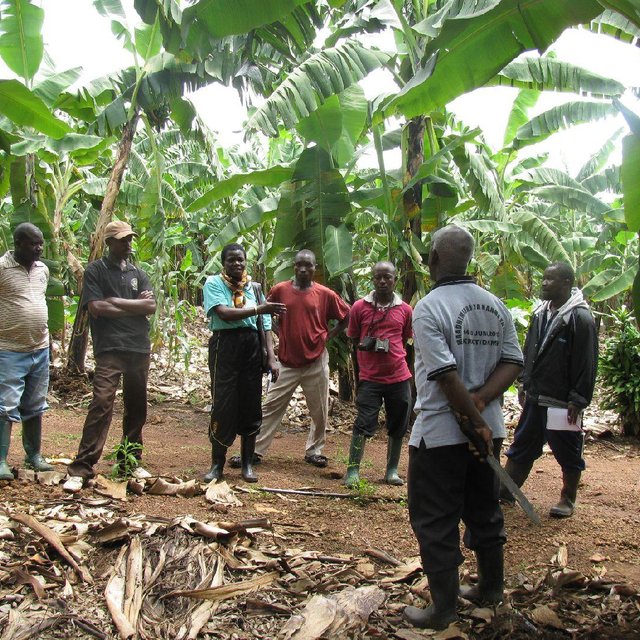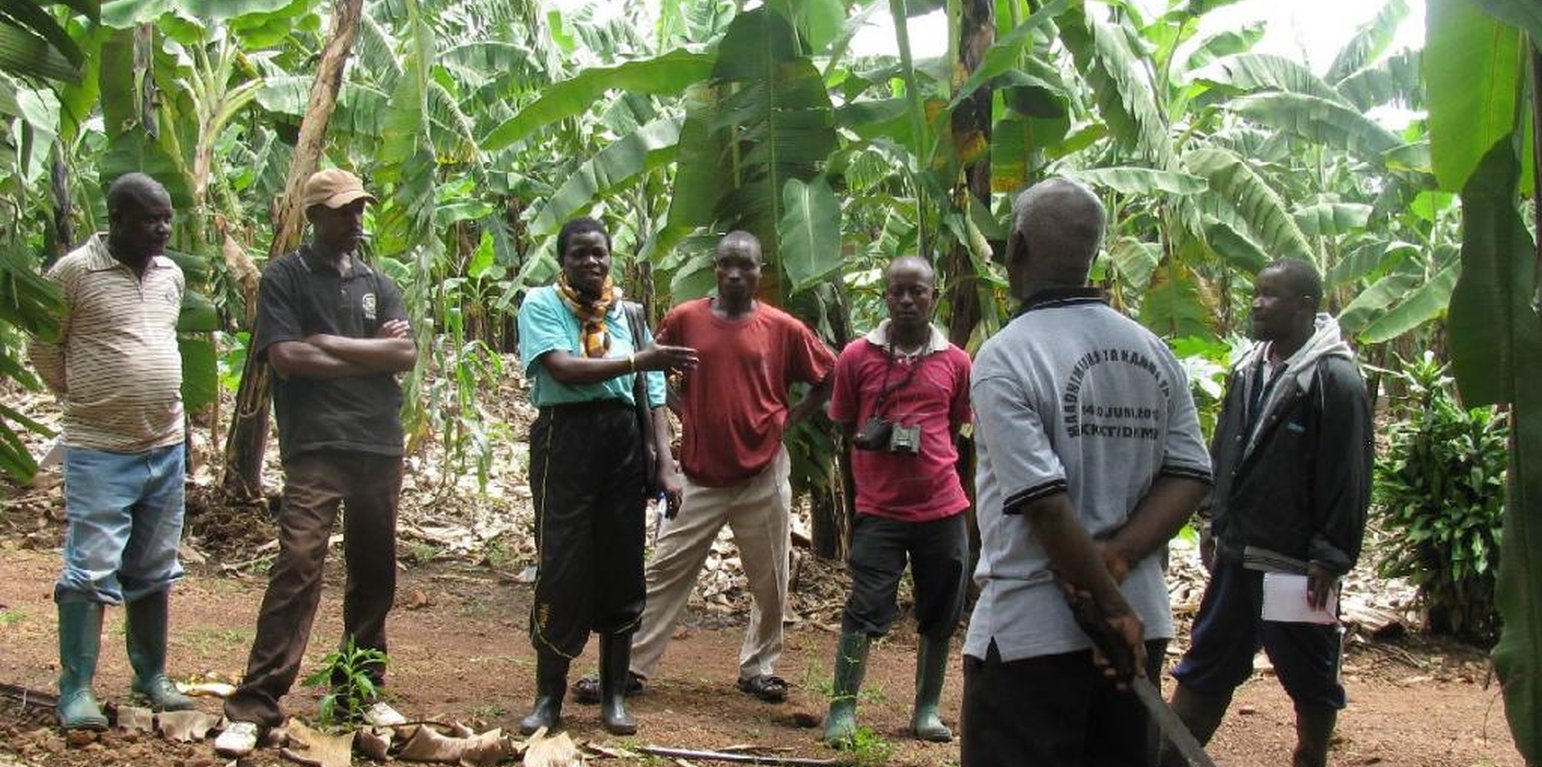Integrated farm knowledge adoption
(Tanzanie)
Tweyambe
Description
The way and means through which a performing farmers adopt and use a combination of indigenous and scientific to maximaze production.
Aims / objectives: To adopt and combine indigenous (traditional) and Scientific knowledge in Kibanja system to improve farm productivity through soil and water use efficiency.
Methods: Continuous adoption of indigenous knowledge through story telling and experience
Adoption of technical knowledge extension officers, knowledgeable farmers, projects and research agencies
Implementing the adopted knowledge to the farm
Stages of implementation: Area identification
Area planned phased and rehabilitation and mitigation
Continuous monitoring and supervision to prevent degradation
Introduce small and large stock for manure production
Role of stakeholders: Land user: Promote and use the technology
Community:Maine implementor of the technology,Source of labour
Extension and research:Provision of technical advise
Financial institution for financial capital support
Clan/Family: Family labour
Other important information: Though land ownership is through customary law, but approach is used by both gender, all family members benefit equally from the use of the approach.
Application of this approach needs integrative and proper conceptual understanding of both indigenous and
Lieu
![]()
Lieu: Missenyi, Kagera, Tanzanie
Géo-référence des sites sélectionnés
Date de démarrage: sans objet
Année de fin de l'Approche: sans objet
Type d'Approche
-
traditionnel/ autochtone
-
initiative/ innovation récente locale
-
fondé sur un projet/ programme
-
Integrated knowledge adoption(traditional,innovative,project)

On farm interview between SLM specialist and Mr.Boko (performing farmer) on his Banana farm at Kyazi Village (Jasson Rwazo (P.O.BOX 38, Missenyi Tanzania))
Objectifs de l'approche et environnement favorable
Principaux objectifs de l'Approche
The Approach focused mainly on SLM with other activities (Improvement of house hold food security and income)
To improve agricultural production and productivity
Sustainable utilization of land and water
To minimize loss during adverse condition (drought/Wind)
To improve house hold food security,income and livelihood
The SLM Approach addressed the following problems: Low agricultural production
Inadequate complementary use of indigenous and technical knowledge
Poor livelihood and income
Conditions favorisant la mise en oeuvre de la/(des) Technologie(s) appliquée(s) sous l'Approche
Conditions entravant la mise en oeuvre de la/(des) Technologie(s) appliquée(s) sous l'Approche
-
Disponibilité/ accès aux ressources et services financiers: Inadequate financial capital
Treatment through the SLM Approach: Phase/Stepwise rehabilitation and expansion
Introducing saving and credit scheme through village bank
-
Connaissances sur la GDT, accès aux supports techniques: Lack of proper integration of indigenous scientific knowledge
Treatment through the SLM Approach: Research
-
Charge de travail, disponibilité de la main-d'œuvre: Lab our intensive
Treatment through the SLM Approach: To modernize the technology to allow mechanisation
Participation et rôles des parties prenantes impliquées dans l'Approche
Parties prenantes impliquées dans l'Approche et rôles
| Quels acteurs/ organismes d'exécution ont été impliqués dans l'Approche? |
Spécifiez les parties prenantes |
Décrivez le rôle des parties prenantes |
| exploitants locaux des terres / communautés locales |
Land user and casual labour |
Approach requires capita |
| chercheurs |
Research institute |
|
Organisme chef de file
Elders developed the approach through trial and error
Participation des exploitants locaux des terres/ communautés locales aux différentes phases de l'Approche
aucun
passive
soutien extérieur
interactive
auto-mobilisation
Prises de décision pour la sélection de la Technologie de GDT
Les décisions ont été prises par
-
les exploitants des terres seuls (auto-initiative)
-
principalement les exploitants des terres soutenus par des spécialistes de la GDT
-
tous les acteurs concernés dans le cadre d'une approche participative
-
principalement les spécialistes de la GDT, après consultation des exploitants des terres
-
les spécialistes de la GDT seuls
-
les responsables politiques/ dirigeants
Les décisions ont été prises sur la base de
-
l'évaluation de connaissances bien documentées en matière de GDT (prises de décision fondées sur des preuves tangibles)?
-
les résultats de recherches?
-
expériences et opinions personnelles (non documentées)
Soutien technique, renforcement des capacités et gestion des connaissances
Les activités ou services suivants ont fait partie de l'approche
-
Renforcement des capacités/ formation
-
Service de conseils
-
Renforcement des institutions (développement organisationnel)
-
Suivi et évaluation
-
Recherche
Financement et soutien matériel externe
Budget annuel en dollars US de la composante GDT
-
< 2 000
-
2 000-10 000
-
10 000-100 000
-
100 000-1 000 000
-
> 1 000 000
Precise annual budget: sans objet
Approach costs were met by the following donors: local community / land user(s) (Land user on his own): 100.0%
Les services ou mesures incitatives suivantes ont été fournis aux exploitants des terres
-
Soutiens financiers/ matériels fournis aux exploitants des terres
-
Subventions pour des intrants spécifiques
-
Crédits
-
Autres incitations ou instruments
Analyses d'impact et conclusions
Impacts de l'Approche
Non
Oui, un peu
Oui, modérément
Oui, beaucoup
Est-ce que l'Approche a aidé les exploitants des terres à mettre en œuvre et entretenir les Technologies de GDT?
Increase of the size of banana bunch, control of erosion and soil nutrient loss
Est-ce que l'Approche a autonomisé les groupes socialement et économiquement défavorisés?
Did other land users / projects adopt the Approach?
Principale motivation des exploitants des terres pour mettre en oeuvre la GDT
Durabilité des activités de l'Approche
Les exploitants des terres peuvent-ils poursuivre ce qui a été mis en oeuvre par le biais de l'Approche (sans soutien extérieur) ?
Conclusions et enseignements tirés
Points forts: point de vue de l'exploitant des terres
Points forts: point de vue du compilateur ou d'une autre personne-ressource clé
Faiblesses/ inconvénients/ risques: point de vue de l'exploitant des terrescomment surmonter
Faiblesses/ inconvénients/ risques: point de vue du compilateur ou d'une autre personne-ressource clécomment surmonter
Références
Date de mise en oeuvre: 5 décembre 2012
Dernière mise à jour: 6 juillet 2017
Personnes-ressources
-
Jasson Rwazo (jassonrwazo@gmail.com) - Spécialiste GDT
Description complète dans la base de données WOCAT
Données de GDT correspondantes
La documentation a été facilitée par




